2013 Peugeot 308 SW BL ignition
[x] Cancel search: ignitionPage 90 of 382

4
88
ACCESS
Triggering of the alarm
The monitoring functions remain
active until the alarm has been trig-
gered eleven times in succession.
When the vehicle is unlocked using
the remote control, rapid fl ashing
of the indicator lamp in the button
informs you that the alarm was trig-
gered during your absence. When
the ignition is switched on, this
fl ashing stops immediately.
Failure of the remote control
To deactivate the monitoring functions:
�)
Lock or deadlock the vehicle using
the key in the driver's door lock.
Locking the vehicle without
activating the alarm
When the ignition is switched on, fi xed
illumination of the indicator lamp in the
button indicates a malfunction of the
system.
Have it checked by a PEUGEOT dealer
or a qualifi ed workshop.
This is indicated by sounding of the si-
ren and fl ashing of the direction indica-
tors for thirty seconds.
�)
Unlock the vehicle using the key in
the driver's door lock.
�)
Open the door; the alarm is
triggered.
�)
Switch on the ignition; the alarm
stops. The indicator lamp in the
button goes off.
Malfunction
Automatic activation *
To be effective, this deactivation
must be carried out each time the
ignition is switched off.
Deactivation of the interior
volumetric monitoring
�)
Switch off the ignition.
�)
Within ten seconds, press the
button until the indicator lamp is on
continuously.
�)
Get out of the vehicle.
�)
Press the locking button on the
remote control immediately.
The exterior perimeter monitoring alone
is activated: the indicator lamp in the
button fl ashes once per second.
Locking the vehicle with
exterior perimeter monitoring
only
Deactivate the interior volumetric moni-
toring to avoid unwanted triggering of
the alarm in certain cases such as:
- leaving a pet in the vehicle,
- leaving a window partially open,
- washing your vehicle.
Reactivation of the interior
volumetric monitoring
�)
Press the unlocking button on the
remote control to deactivate the
exterior perimeter monitoring.
�)
Press the locking button on the
remote control to activate all the
monitoring functions.
The indicator lamp in the button again
fl ashes once per second.
*
According to country.
2 minutes after the last door or the boot
is closed, the system is activated auto-
matically.
�)
To avoid triggering the alarm on entering
the vehicle, fi rst press the unlocking
button on the remote control.
Page 91 of 382
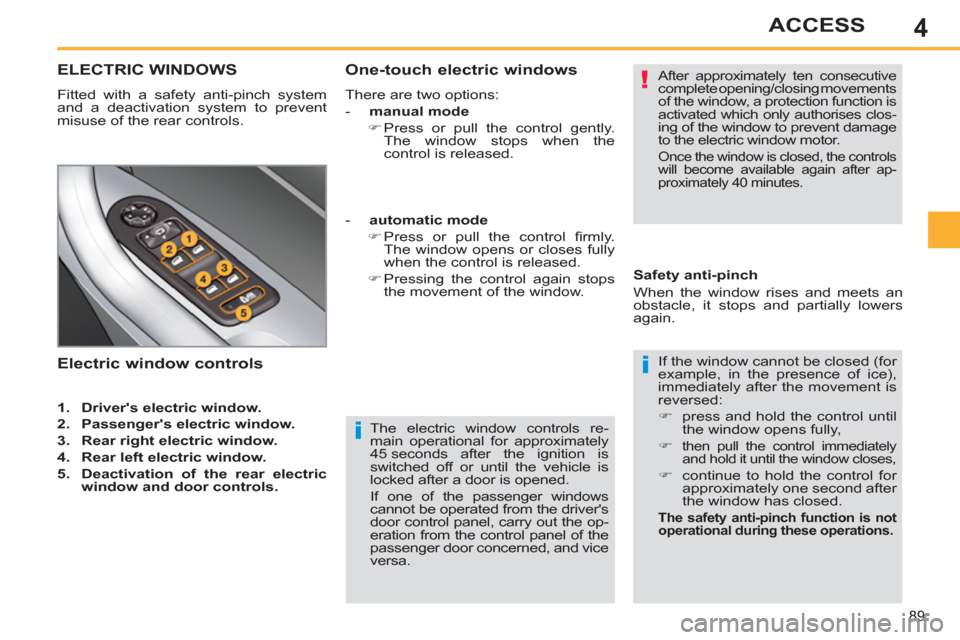
4
89
ACCESS
The electric window controls re-
main operational for approximately
45 seconds after the ignition is
switched off or until the vehicle is
locked after a door is opened.
If one of the passenger windows
cannot be operated from the driver's
door control panel, carry out the op-
eration from the control panel of the
passenger door concerned, and vice
versa.
ELECTRIC WINDOWS
Fitted with a safety anti-pinch system
and a deactivation system to prevent
misuse of the rear controls.
Electric window controls
If the window cannot be closed (for
example, in the presence of ice),
immediately after the movement is
reversed:
�)
press and hold the control until
the window opens fully,
�)
then pull the control immediately
and hold it until the window closes,
�)
continue to hold the control for
approximately one second after
the window has closed.
The safety anti-pinch function is not
operational during these operations.
Safety anti-pinch
When the window rises and meets an
obstacle, it stops and partially lowers
again.
- automatic mode
�)
Press or pull the control fi rmly.
The window opens or closes fully
when the control is released.
�)
Pressing the control again stops
the movement of the window.
One-touch electric windows
There are two options:
- manual mode
�)
Press or pull the control gently.
The window stops when the
control is released.
After approximately ten consecutive
complete opening/closing movements
of the window, a protection function is
activated which only authorises clos-
ing of the window to prevent damage
to the electric window motor.
Once the window is closed, the controls
will become available again after ap-
proximately 40 minutes.
1.
Driver's electric window.
2.
Passenger's electric window.
3.
Rear right electric window.
4.
Rear left electric window.
5.
Deactivation of the rear electric
window and door controls.
Page 92 of 382

4
90
ACCESS
This control also deactivates the
interior controls for the rear doors
(refer to the section "Child safety -
Electric child lock").
Reinitialisation
If a window does not rise automatically,
its operation must be reinitialised:
�)
pull the control until the window
stops,
�)
release the control and pull it again
until the window closes fully,
�)
continue to hold the control for
approximately one second after the
window has closed,
�)
press the control to lower the window
automatically to the low position,
�)
when the window has reached the
low position, press the control again
for approximately one second.
Always remove the key from the
ignition when leaving the vehicle,
even for a short time.
If an obstacle is encountered during
operation of the electric windows,
you must reverse the movement of
the window. To do this, press the
control concerned.
When the driver operates the con-
trols for the passengers' electric
windows, they must ensure that no
one is preventing correct closing of
the windows.
The driver must ensure that the pas-
sengers use the electric windows
correctly.
Be aware of children when operating
the windows.
Deactivation of the rear electric
window and door controls
�)
For the safety of your children, press
control 5
to deactivate the rear
electric window controls regardless
of their position.
Indicator lamp on, the rear controls are
deactivated.
Indicator lamp off, the rear controls are
activated.
The safety anti-pinch function is not
operational during these operations.
Page 98 of 382
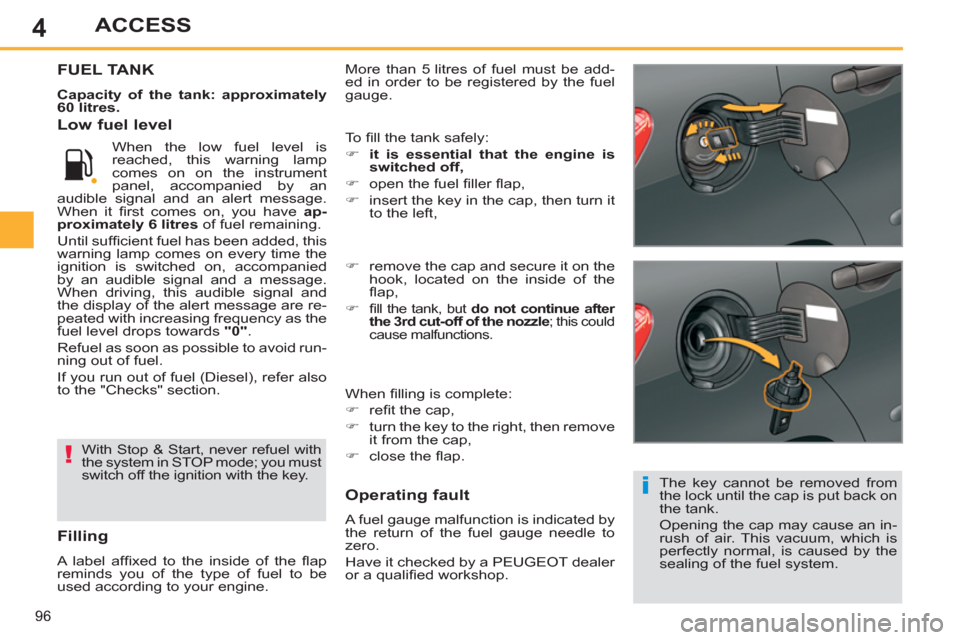
4
96
ACCESS
More than 5 litres of fuel must be add-
ed in order to be registered by the fuel
gauge. FUEL TANK
Capacity of the tank: approximately
60 litres.
The key cannot be removed from
the lock until the cap is put back on
the tank.
Opening the cap may cause an in-
rush of air. This vacuum, which is
perfectly normal, is caused by the
sealing of the fuel system.
Low fuel level
Operating fault
A fuel gauge malfunction is indicated by
the return of the fuel gauge needle to
zero.
Have it checked by a PEUGEOT dealer
or a qualifi ed workshop.
Filling
A label affi xed to the inside of the fl ap
reminds you of the type of fuel to be
used according to your engine. When the low fuel level is
reached, this warning lamp
comes on on the instrument
panel, accompanied by an
audible signal and an alert message.
When it fi rst comes on, you have ap-
proximately 6 litres
of fuel remaining.
Until suffi cient fuel has been added, this
warning lamp comes on every time the
ignition is switched on, accompanied
by an audible signal and a message.
When driving, this audible signal and
the display of the alert message are re-
peated with increasing frequency as the
fuel level drops towards "0"
.
Refuel as soon as possible to avoid run-
ning out of fuel.
If you run out of fuel (Diesel), refer also
to the "Checks" section.
With Stop & Start, never refuel with
the system in STOP mode; you must
switch off the ignition with the key.
�)
remove the cap and secure it on the
hook, located on the inside of the
fl ap,
�)
fi ll the tank, but do not continue after
the 3rd cut-off of the nozzle
; this could
cause malfunctions.
When fi lling is complete:
�)
refi t the cap,
�)
turn the key to the right, then remove
it from the cap,
�)
close the fl ap.
To fi ll the tank safely:
�)
it is essential that the engine is
switched off,
�)
open the fuel fi ller fl ap,
�)
insert the key in the cap, then turn it
to the left,
Page 103 of 382
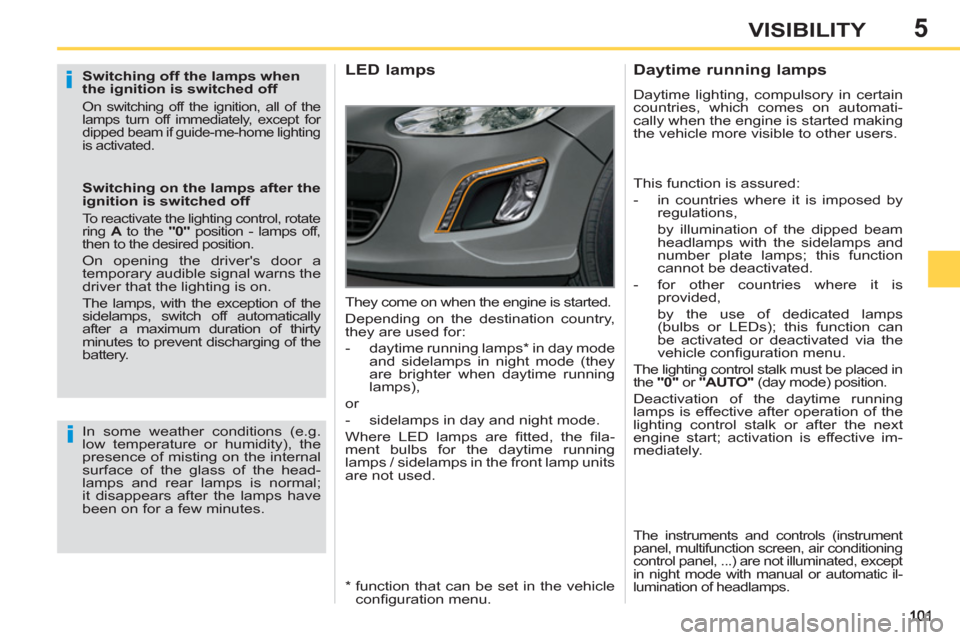
5VISIBILITY
Switching off the lamps when
the ignition is switched off
On switching off the ignition, all of the
lamps turn off immediately, except for
dipped beam if guide-me-home lighting
is activated.
Switching on the lamps after the
ignition is switched off
To reactivate the lighting control, rotate
ring A
to the "0"
position - lamps off,
then to the desired position.
On opening the driver's door a
temporary audible signal warns the
driver that the lighting is on.
The lamps, with the exception of the
sidelamps, switch off automatically
after a maximum duration of thirty
minutes to prevent discharging of the
battery.
LED lamps
In some weather conditions (e.g.
low temperature or humidity), the
presence of misting on the internal
surface of the glass of the head-
lamps and rear lamps is normal;
it disappears after the lamps have
been on for a few minutes.
Daytime running lamps
Daytime lighting, compulsory in certain
countries, which comes on automati-
cally when the engine is started making
the vehicle more visible to other users.
This function is assured:
- in countries where it is imposed by
regulations,
by illumination of the dipped beam
headlamps with the sidelamps and
number plate lamps; this function
cannot be deactivated.
- for other countries where it is
provided,
by the use of dedicated lamps
(bulbs or LEDs); this function can
be activated or deactivated via the
vehicle confi guration menu.
The lighting control stalk must be placed in
the "0"
or "AUTO"
(day mode) position.
Deactivation of the daytime running
lamps is effective after operation of the
lighting control stalk or after the next
engine start; activation is effective im-
mediately.
The instruments and controls (instrument
panel, multifunction screen, air conditioning
control panel, ...) are not illuminated, except
in night mode with manual or automatic il-
lumination of headlamps.
They come on when the engine is started.
Depending on the destination country,
they are used for:
- daytime running lamps * in day mode
and sidelamps in night mode (they
are brighter when daytime running
lamps),
or
- sidelamps in day and night mode.
Where LED lamps are fi tted, the fi la-
ment bulbs for the daytime running
lamps / sidelamps in the front lamp units
are not used.
*
function that can be set in the vehicle
confi guration menu.
Page 104 of 382
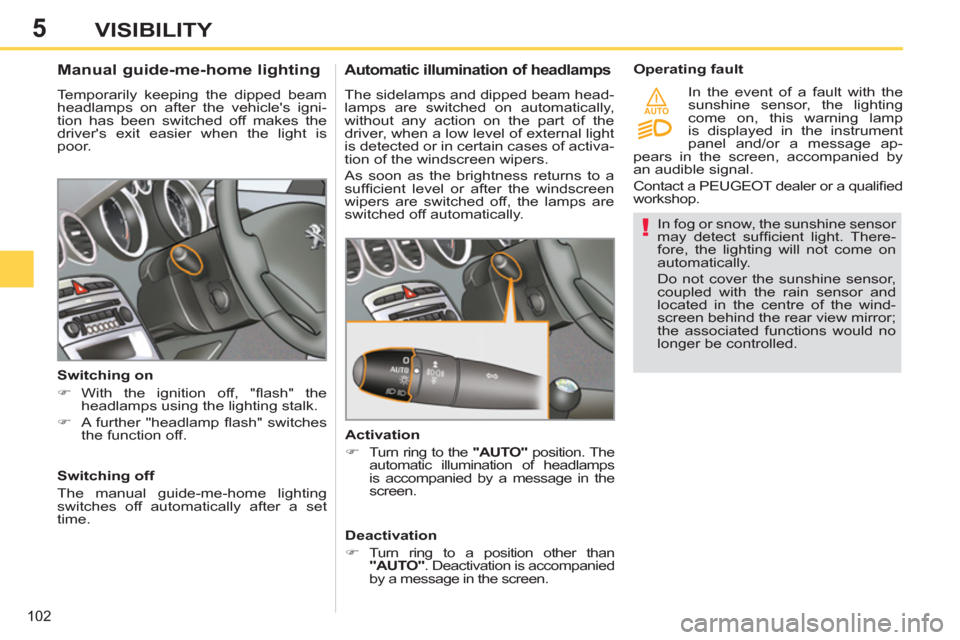
5
AUTO
102
VISIBILITY
In fog or snow, the sunshine sensor
may detect suffi cient light. There-
fore, the lighting will not come on
automatically.
Do not cover the sunshine sensor,
coupled with the rain sensor and
located in the centre of the wind-
screen behind the rear view mirror;
the associated functions would no
longer be controlled.
Operating fault
In the event of a fault with the
sunshine sensor, the lighting
come on, this warning lamp
is displayed in the instrument
panel and/or a message ap-
pears in the screen, accompanied by
an audible signal.
Contact a PEUGEOT dealer or a qualifi ed
workshop.
Manual guide-me-home lighting
Temporarily keeping the dipped beam
headlamps on after the vehicle's igni-
tion has been switched off makes the
driver's exit easier when the light is
poor.
Switching on
�)
With the ignition off, "fl ash" the
headlamps using the lighting stalk.
�)
A further "headlamp fl ash" switches
the function off.
Switching off
The manual guide-me-home lighting
switches off automatically after a set
time.
Automatic illumination of headlamps
The sidelamps and dipped beam head-
lamps are switched on automatically,
without any action on the part of the
driver, when a low level of external light
is detected or in certain cases of activa-
tion of the windscreen wipers.
As soon as the brightness returns to a
suffi cient level or after the windscreen
wipers are switched off, the lamps are
switched off automatically.
Activation
�)
Turn ring to the "AUTO"
position. The
automatic illumination of headlamps
is accompanied by a message in the
screen.
Deactivation
�)
Turn ring to a position other than
"AUTO"
. Deactivation is accompanied
by a message in the screen.
Page 105 of 382
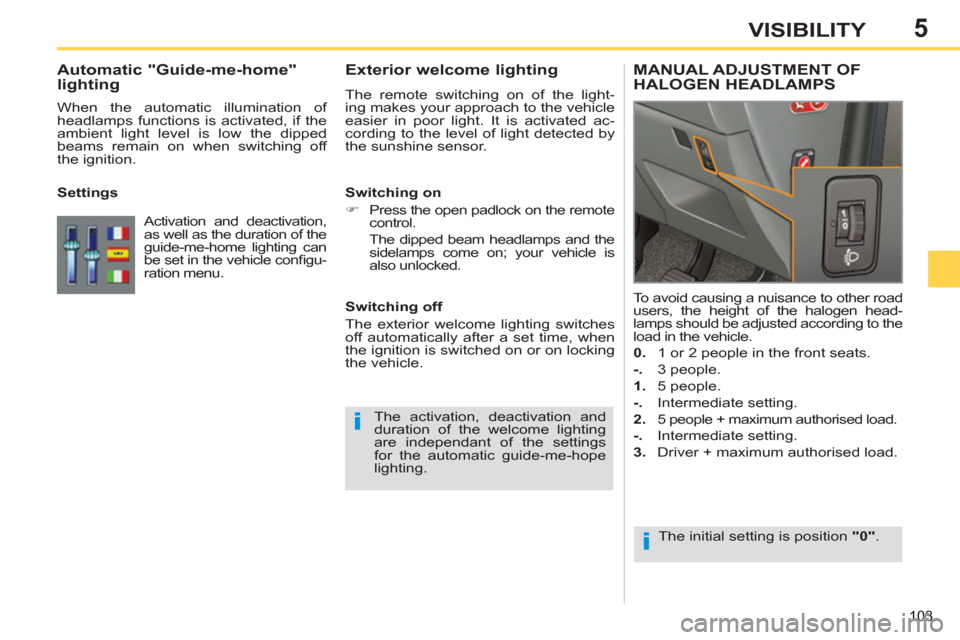
5
103
VISIBILITY
Exterior welcome lighting
The remote switching on of the light-
ing makes your approach to the vehicle
easier in poor light. It is activated ac-
cording to the level of light detected by
the sunshine sensor.
Switching on
�)
Press the open padlock on the remote
control.
The dipped beam headlamps and the
sidelamps come on; your vehicle is
also unlocked.
Switching off
The exterior welcome lighting switches
off automatically after a set time, when
the ignition is switched on or on locking
the vehicle.
MANUAL ADJUSTMENT OFHALOGEN HEADLAMPS
The initial setting is position "0"
.
To avoid causing a nuisance to other road
users, the height of the halogen head-
lamps should be adjusted according to the
load in the vehicle.
0.
1 or 2 people in the front seats.
-.
3 people.
1.
5 people.
-.
Intermediate setting.
2.
5 people + maximum authorised load.
-.
Intermediate setting.
3.
Driver + maximum authorised load.
The activation, deactivation and
duration of the welcome lighting
are independant of the settings
for the automatic guide-me-hope
lighting.
Automatic "Guide-me-home"
lighting
When the automatic illumination of
headlamps functions is activated, if the
ambient light level is low the dipped
beams remain on when switching off
the ignition.
Settings
Activation and deactivation,
as well as the duration of the
guide-me-home lighting can
be set in the vehicle confi gu-
ration menu.
Page 106 of 382

5VISIBILITY
DIRECTIONAL LIGHTING
When the dipped or main beam head-
lamps are on, this function enables the
light beams to provide improved lighting
of the side of the road when cornering.
The use of this function, from approxi-
mately 12 mph (20 km/h) and associ-
ated with the xenon headlamps only,
considerably improves the quality of
your lighting when cornering.
with directional lighting
without directional lighting
Programming
Operating fault
The function is activated or
deactivated via the vehicle
confi guration menu.
If a fault occurs, this warning
lamp fl ashes in the instrument
panel, accompanied by a mes-
sage in the screen.
Contact a PEUGEOT dealer or a qualifi ed
workshop.
AUTOMATIC ADJUSTMENT OF XENON HEADLAMPS
Do not touch the xenon headlamp
bulbs.
Contact a PEUGEOT dealer or a
qualifi ed workshop. In order to avoid causing a nuisance to
other road users, this system corrects the
height of the xenon headlamp beams au-
tomatically and when stationary, in relation
to the load in the vehicle.
If a malfunction occurs, this
warning lamp is displayed on
the instrument panel, accom-
panied by an audible signal
and a message in the screen.
The system then places your headlam-
ps in the lowest position. When stationary or moving at very
low speed or when reverse gear is
engaged, the function is inactive.
The status of the function remains
in the memory when the ignition is
switched off.